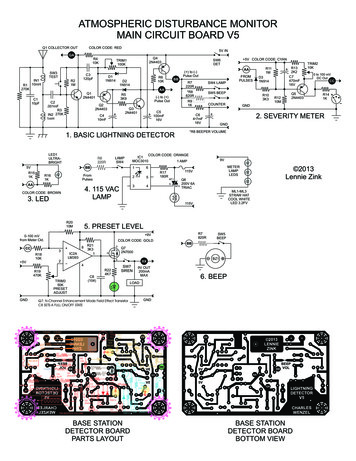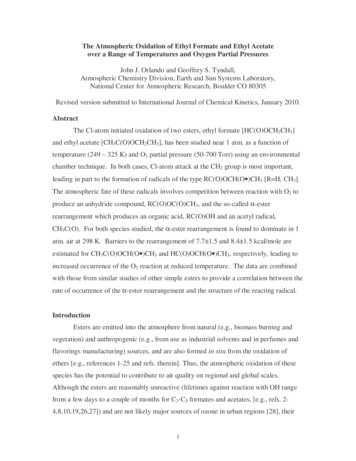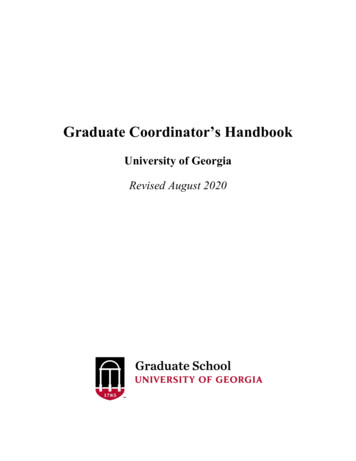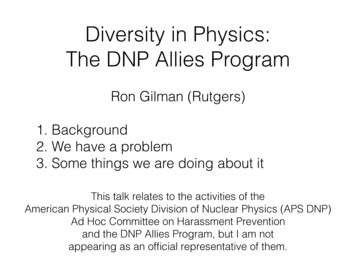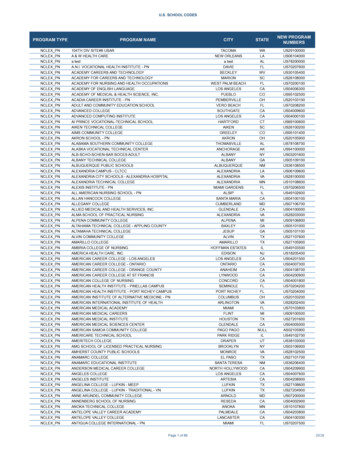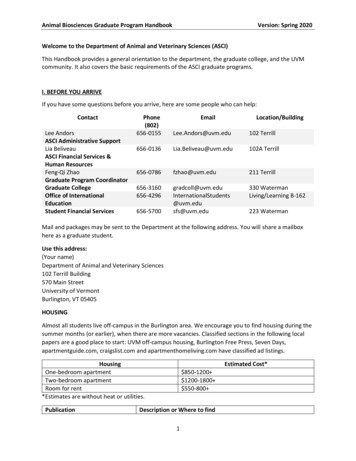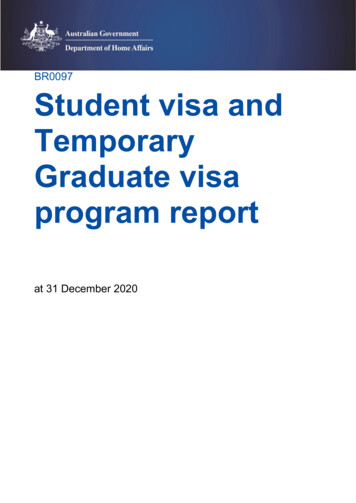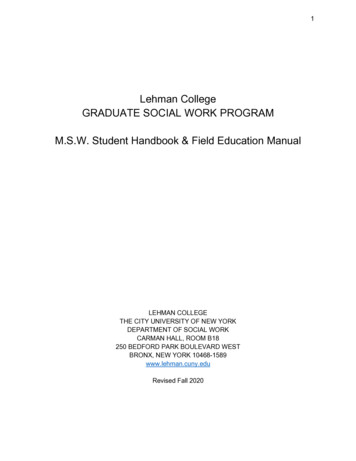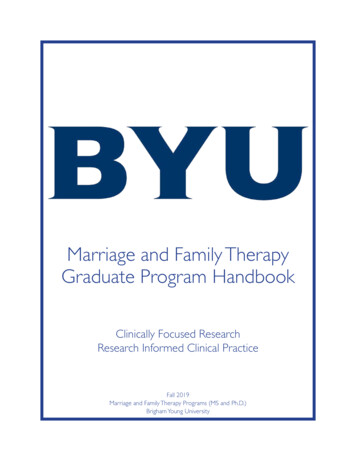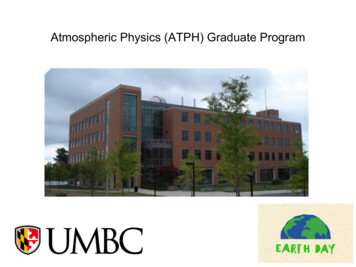
Transcription
Atmospheric Physics (ATPH) Graduate Program
Overview of UMBCØ 14,000 Students 11,000 undergrad 3,000 gradØ 37 Academic Programs 21 PhD programs
Overview of UMBCØ 14,000 Students 11,000 undergrad 3,000 gradØ 37 Academic Programs 21 PhD programsARLAPLNRLNSANorthropGrumman NASAGoddard .
UMBC Physics Department 20 regular faculty 15 research faculty 50 graduate students 150 ugrad majors
4 main research areas at UMBCAtmosphericPhysicsAstrophysicsAtmospheric Physics (ATPH)PhD program:ATPH program accounts for¼ of faculty, 1/3 of graduatestudentsCondensedMatter PhysicsPhysics PhD programQuantum Optics& Information
We are #1 “Atmospheric Physics” Program
Atmospheric Physics Program(Research-driven and oriented)Faculty MembersProf. Belay DemozProf. Lynn SparlingProf. Zhibo ZhangProf. Vanderlei MartinsProf. Pengwang ZhaiMajor Research Directions:Aerosol/cloud remote sensing Ocean color remote sensing Remote sensing instrumentation Air pollution Extreme weather Climate model evaluation andimprovement Machine-learning and AI for remotesensing and climate study more info:Zhibo.Zhang@umbc.edu(410)-455-6315
Dr. Belay B. DemozUMBC-Physics/JCETQuestions:Whatphysics dynamicsobservation and networksHow do we measure the these processes?What type of instruments and what quality?Networks: linking observation fromdifferent sites – to solve a climateand weather problem. Example hereis from a climate network GRUAN.Instrumentation: physics, network capability, What and how can weimprove on multi-instrumentation networks? How should they be deployed.ABAWAVES 2006Beltsville, MDBGRUAN 2016Beltsville, MDDiagnosing Model physics; Use the observation to constrain,validate, improve models. .Making sense of what is measured: An exampleof cold front generated bore and associated roleundulations during PECAN
www.umbc.edu/lacoL A COmartins@umbc.eduPhysicsDepartmentLaboratory for Aerosols, Clouds and OpticsNew Remote Sensing Instrumentsand AlgorithmsThe picture can'tbe displayed.InstrumentDevelopmentLaboratory Simulations and MeasurementsField and AircraftMeasurementsInstrumentField andDevelopmentAircraft MeasurementsThe picture can't be displayed.
First UMBC SatelliteUnderway
Lynn Sparling Research areas:Hurricane Katrina hot towers(TRMM)Hurricanes:Small scale processes in theeye and eyewall and links to intensity change.Low level winds:Energy generation andboundary layer dynamics.Long-range transport:Tracking SO2 emissions from volcanoes.sparling@umbc.edu
Aerosol, Cloud, RadiationObservation and Simulation(ACROS) Group led byDr. Zhibo ZhangSupported byNASADepartment of Energy (DOE)National Science Foundation (NSF)
ite-based Cloud/Aerosol Remote SensingRadiative effects of aerosolsAerosol-cloud-radiation interactionsClimate modeling and evaluation
Quest:'To'develop'new'Dr. Pengwang Zhai op0cal'remote'sensing'Physics Department, UMBC methods'for'ocean'water''and'aerosols.'Optical Remote SensingLight ScatteringRadiative Transfer
Earth Science Joint Centerwith NASA Goddard7/1/95 – 6/30/98 -– (H. Melfi)7/1/98 – 12/31/05 - (Melfi/Hoff )10/1/05 – 9/30/10 - (Hoff )10/1/10 – 9/30/15 – (Hoff/ Eichenlaub)10/1/15 – 9/30/20 – (Demoz)Beyond the numbers: 2011-2017: 800 journal papers 2006-2018: 138 graduate students Hundreds of undergradsJCET 2020: Celebrating 25 years ofcollaborative research and education
JCET: By the numbers2017-2018 JCET CompositionAdminCoac., 5ntrtual,6UndergraduateStudents, 14GraduateStudent, 7ResearchSupport, 6ResearchFaculty, 46Research AnalystsFaculty Research AssistantsAssociate Research EngineerAssistant Research EngineerResearch Assistant ProfessorsAssistant Research ScientistsAssociate Research ScientistsResearch Associate ProfessorsSenior Research ScientistsResearch ProfessorPost-Doc Research AssociatesProgram CoordinatorAdministrative StaffContractualUndergraduate StudentsGraduate StudentsTotal52116441066615614784
JCET: Teaching ContributionPHYSICSPHYS 621: Intro to Atmospheric SciencePHYS 622: Clouds, Aerosol and RadiationCSEEPHYS 640/440: Computational PhysicsCSMC 626: Computer SecurityPHYS 721: Atmospheric RadiationPHYS 741: Inverse MethodsPHYS 335: Physics & Chemistry of the AtmospherePHYS 112: Basic Physics IIJCET Seminars – Professional Development for graduate students:PHYS 650: Precipitation Science (Spring 2018)Honors College:Climate Change & Public PolicyProposed:Interdisciplinary Climate Change(undergraduate)GESGES 302: Arctic GeographyGES 311: Weather and ClimateGES 381: Remote SensingGES 400x: Earth’s CryosphereGES 415: Climate ChangeGES 481/681: Remote Sensing and ImageProcessing for Environmental Applications
Mixing Layer Heightor“Boundary Layer Height”Ø Diagnostic variable atmospheric transport and dispersionforecasting models.Ø Without realistic PBL heights models have large errorsthat result in inadequate public protection againstunhealthy air quality.Ø National Research Council has recommended a“network of networks”1 After 60 years of remote sensing research, it isastounding that the PBL is not measured regularlythroughout its diurnal cycle1- NRC. 2009. Observing Weather and Climate from the Ground Up: ANationwide Network of Networks. Washington, DC: National AcademyPress.
Observations Lead The WayNRCR. HoffObserving Weather and Climatefrom the Ground Up: A NationwideNetwork of Networks (2009)Ceilometers!!!Regional TestbedNSFB. DemozThermodynamic ProfilingTechnology Workshop (2011)NASEMR. DelgadoThe Future of Atmospheric BoundaryLayer Observing, Understanding, andModeling (2018)*Compton et al. (2013), J. Atmos. Ocean.Tech., doi:10.1175/JTECHD-12-00116.1
Air Quality:www.lidar.umbc.edu or Search for “smogblog”Land-water differences in O3 within the boundary layerand correlation of diurnal evolution of dynamics andchemistry.Hart Miller IslandWhat source groups and locations do policy makers need to focus on to reduceozone over the Chesapeake Bay? Power Plants and Poultry/Agriculture Industry Impacting Air Quality in theChesapeake Bay
Interdisciplinary ResearchUndergraduate and GraduateStudentsAtmospheric PhysicsBiologyComputer Science and ElectricalEngineeringGeography and Environmental SystemsMath and StatisticsMechanical EngineeringPhysicsMixing Layer HeightNetwork TestbedState and Federal StakeholdersMDE, EPA, NOAA, NASA
“Lidar Compound Eye” View of the World:Carbon ManagementAll wind capacity is not createdequal: untangling uncertaintiesin offshore wind energydevelopment.Coastal Doppler Wind LidarMeasurements Focuses on building bridgesbetween atmospheric scienceand public policy to help reduceeconomic uncertainties in theoffshore wind energy industry
UMBC’s newest research center: the Earth and SpaceInstitute (ESI).
Multiple opportunities available for graduate studentsØØØØØGAANN FellowshipJCET research fellowshipResearch assistantshipTeaching assistantshipNASA/NSF fellowshipJCET FellowshipRecent NASA NESSF fellowshipRecent graduatesNASA postdoc program (working for NASA!)GAANN Fellowship
Contact informationImportant LinksØ UMBC Physics department http://physics.umbc.edu/Ø UMBC ATPH program http://physics.umbc.edu/research/atmospheric/Ø UMBC graduate school http://gradschool.umbc.edu/Ø UMBC Joint Center for Earth Systems Technology (JCET) http://jcet.umbc.edu/Contact InformationZhibo Zhang: ATPH program directorZhibo.Zhang@umbc.edu(410) 455-6315Apply for ATPH program today
Overview of UMBC Ø14,000 Students 11,000 undergrad 3,000 grad Ø37 Academic
